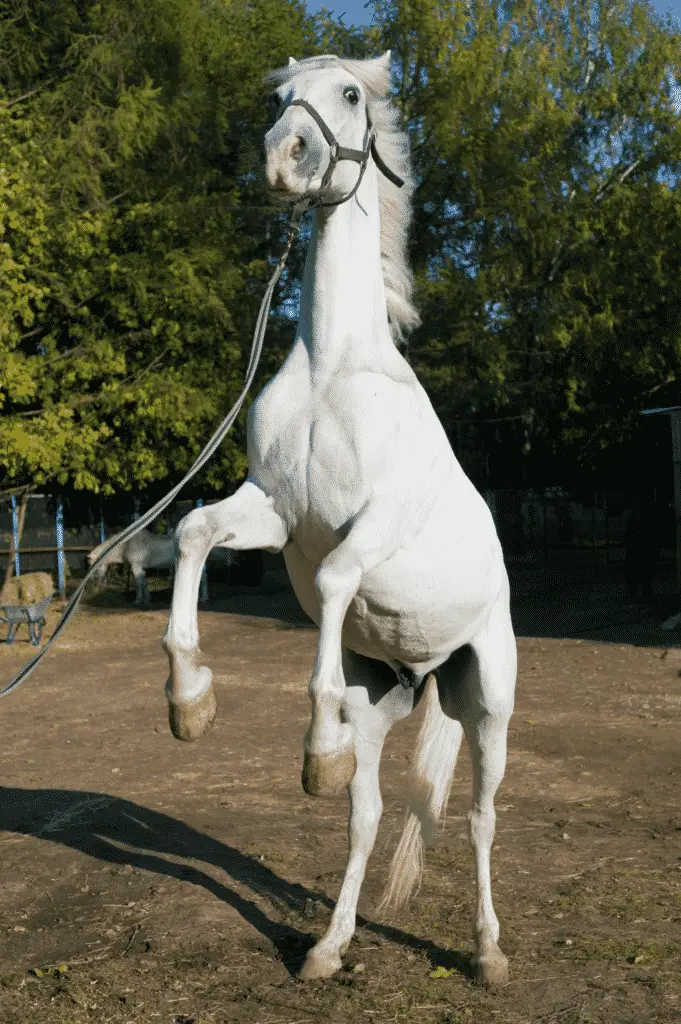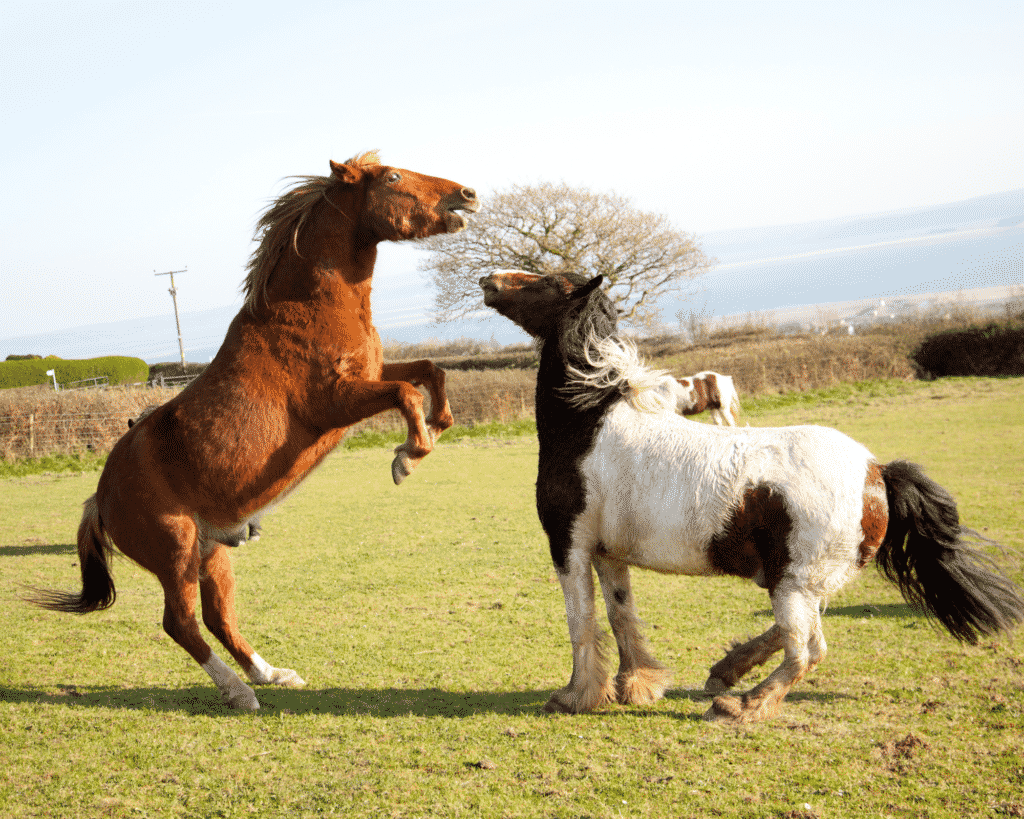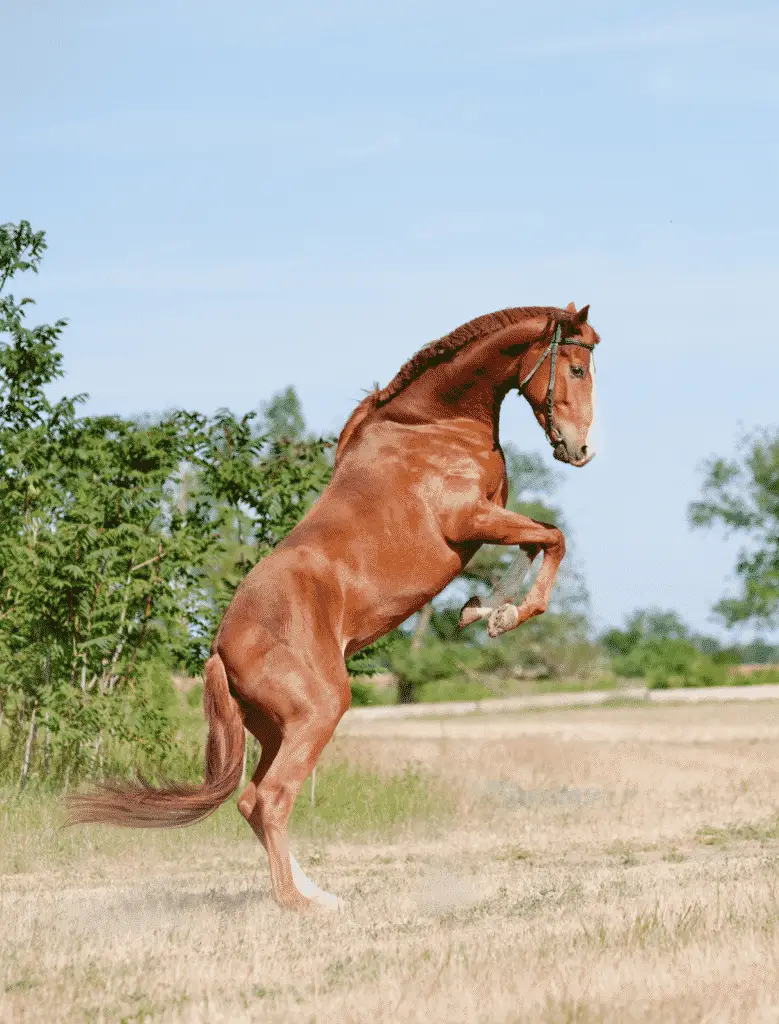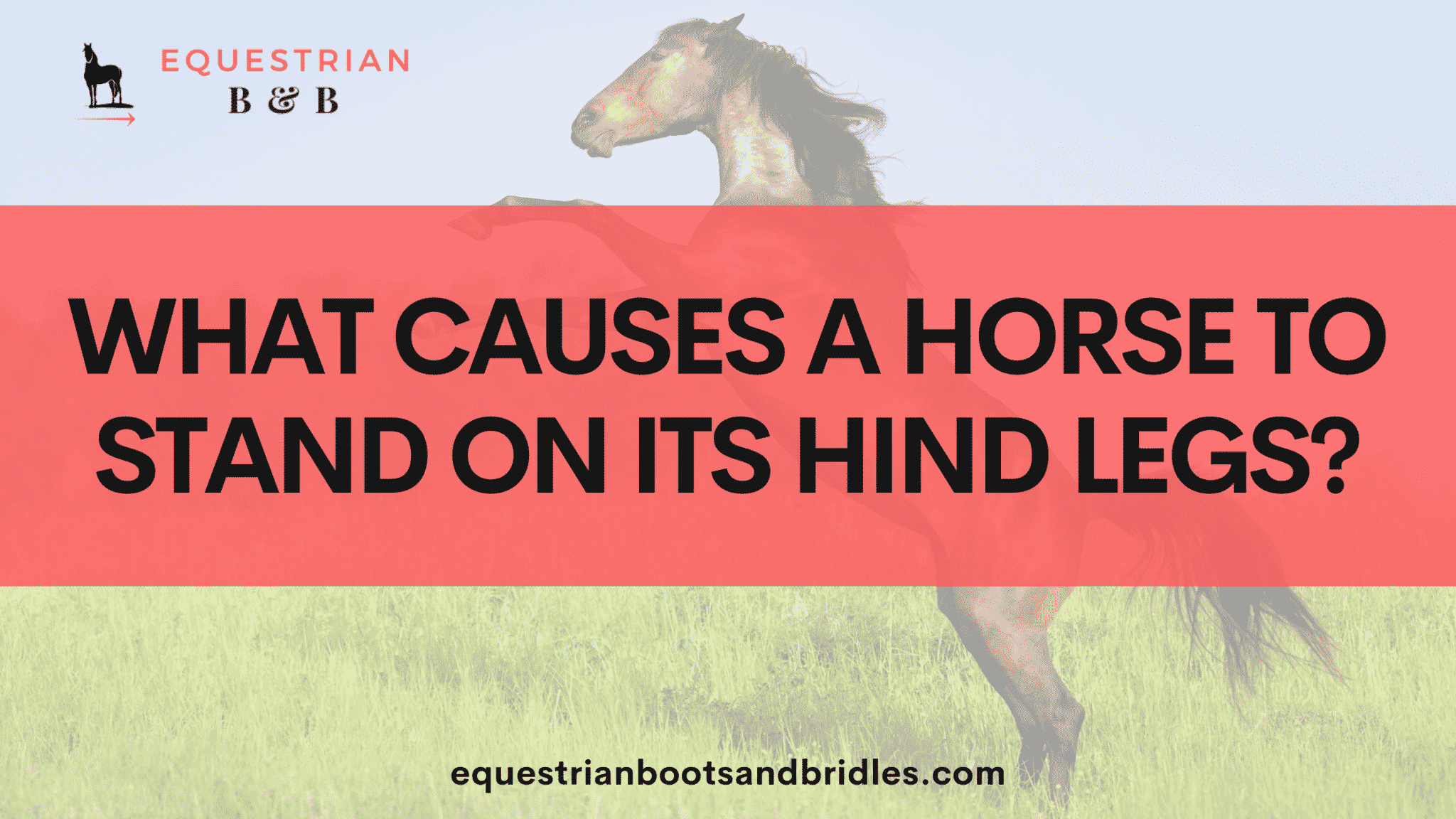It will unnerve most riders to have their horse standing on hind legs (especially when they didn’t anticipate or ask for this behavior!). Rearing, as it is more commonly called, is a behavior we normally see in the wild with stallions when they stand up on their hind legs and kick out at each other while fighting.
But when you’re not in the wild… Why would your horse stand on its hind legs, and how can you stop this dangerous behavior?
What Is Rearing in Horses?
To start, I always tell people to remember there is a difference between rearing and bucking. When a horse bucks, they kick out backward. A rearing horse, however, will raise their front end off the ground, kicking out its front legs with both front feet off the ground while its body is erect.
In most cases, this is aggressive behavior from an animal that is nervous or scared. It can also be a sign of defiance.
While stallions can perform this move in a fight, it is dangerous for a person to face a rearing horse that could easily harm them. Sometimes, a handler might barely escape with their life if a horse rears and kicks out at them.
It can be scary to watch a horse standing up on its hind legs. However, it’s not always something dangerous. Trick horses are trained to balance on their hindquarters, raise their head and front legs, and kick out or even start walking forward on command. A Google search can show you trick trainers like Ben Atkinson’s Action Riders, who train horses for shows with rearing and jumping acrobatics. These show animals can draw chariots, break shields, and leap into the air while kicking backward.
Horses Rearing: The Why and How

There are several reasons why horses may rear up. Sometimes, horses will rear while you lead them if you pull the bit back too hard while riding them (which might hurt their mouth). Or they may rear up if they get kicked by the horse ahead of them. A horse that has a saddle fit problem or is in pain may also rear up when ridden in this condition. (Click here for our guide to making sure you measure correctly for your saddle.)
Horses need to be incredibly powerful to rear up on their hindquarters, bracing their body weight on their hind legs while they kick out with their front feet. While rearing up, a horse may even balance on one hoof or jump forward while resting their full weight on a heel as they raise their head upwards even more.
If a horse standing up on their hind legs ever requires your intervention, be aware that tapping the horse on its lower legs with a whip will not stop the rearing, but rather provoke it. Likewise, before you discipline what you may see as dangerous behavior, you should consider whether rearing and striking out are signs of pain and discomfort. Trying to discipline your horse’s rearing behavior may just make it worse!
Signs of Pain Induced Rearing
Signs that a horse is in pain include rearing, bucking, and twisted body parts such as a tail held to the side or tucked in when in the resting position. A nose that is wrinkled and turned to the side could also indicate severe pain. If the horse has pain in their front legs, they may also resolve this by rearing, or use rearing as a way not to carry a rider. Rearing can help take the weight off their front legs.
Rearing can also indicate pain in the horse’s neck and spine or if an ill-fitting saddle hurts the horse when the rider’s weight is in the saddle. Consulting your vet is a great idea in this case, so they can rule out any causes of pain that may trigger the rearing.
When Rearing Is Normal… and What to Do About It

Rearing is normal for horses, and it isn’t always caused by pain. Young foals will rear while playing as they try to establish dominance. Stallions rear up to cover mares. And any horse may rear up when they fight. When a horse feels threatened, they may use rearing as a defense when they have nothing else left with which to defend themselves.
If a horse rears up when you work with them, it is important to stay calm. When you are on the ground, you are most vulnerable. A horse can strike you in the head when they are rearing and they may pull the line or lead out of your hand if you aren’t careful. Having the weight of a fully grown horse crash down on you can break your bones, cause serious injuries, and even lead to death. So, whether you have a stallion, gelding, or mare, you should always lead them with a loose enough rein to control them, but not get pulled under their hooves.
Should you be on your horse when they suddenly start rearing up, you need to quickly do damage control of the situation. If you pull back on their reins, you risk that your horse could fall over backward, break a leg, or fall on you and break your back. Instead, lean forward when a horse is standing up. Lie forward on the horse’s neck, using your weight to throw them forward as you try to get them to stop the behavior.
A horse that starts rearing, bucking, or trying to run off with the rider is trying to make them fall. To try and stop the rearing, try to keep the horse’s front feet on the ground by riding the horse forward. The rider’s posture will help ensure the horse thinks forward and not up.

Horse Rearing FAQs
What do I do about a horse that starts rearing up when I enter their pasture?
This horse is being dominant, and it is important to keep them out of your space. Use a lunge line or whip to make the horse move their feet and back away from you. Keep clear of their legs to avoid getting kicked. Address the signs of disrespect or pain by having the vet check your horse. If it is a pain reaction, you may have to rest your horse for several weeks while they heal before you handle them or ride them.
How do I teach a horse to rear up on their back legs?
It is possible to train a horse to stand on their hind legs. Start by having a halter fitted to the horse’s head with a D-ring on the noseband. Keep the horse’s nose pointed away from you as you gently encourage the horse to start backing onto their hind legs while raising their nose up and tapping the horse on their front legs below the knee.
When the horse raises their front legs, gently raise their nose more and rock the horse further back onto their hind foot. Eventually, the sign for rearing will be as simple as raising your arms or pointing at their front feet with a riding whip. Never use pain as a way to get your horse trained to rear.
How tall is a horse standing up on their hind legs?
While nobody’s been able to really measure a horse when rearing, the act of rearing does raise the horse’s head, creating a risk that if they rear in a horse float or in their stable, they may hit their head. Therefore, a stable’s roof should be a minimum height of 12 feet.
What is it called when a horse stands on its hind legs?
When a horse stands on its hind legs, it’s called rearing.
Conclusion
A trained handler can control a rearing horse that works at liberty or is loose, but the majority of riders run the risk of serious injury and even death if they try to control a rearing horse. When a horse tries to stand too close in your space, you should back away or stand next to their shoulder to avoid getting kicked.
To prevent rearing as a pain reaction, ensure your horse’s saddle fits correctly, that they aren’t in pain, and are happy animals with enough pasture time to relax and be wild. A horse has a powerful body that can deliver so much force when they use their hindquarters to rest on or kick out from. Experienced trainers use this power to create highly intelligent and trained horses that perform tricks and keep young and old entertained.
Yet, when your horse rears up their front end, these tricks will be the furthest thing from your mind as you focus on surviving a dangerous situation that could see you trampled under the weight of your horse’s feet.

